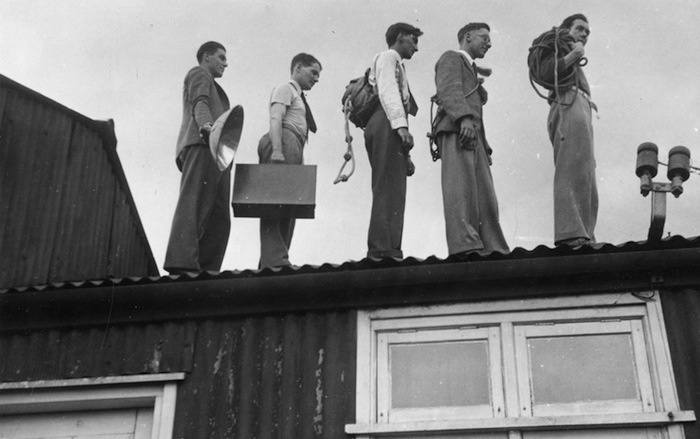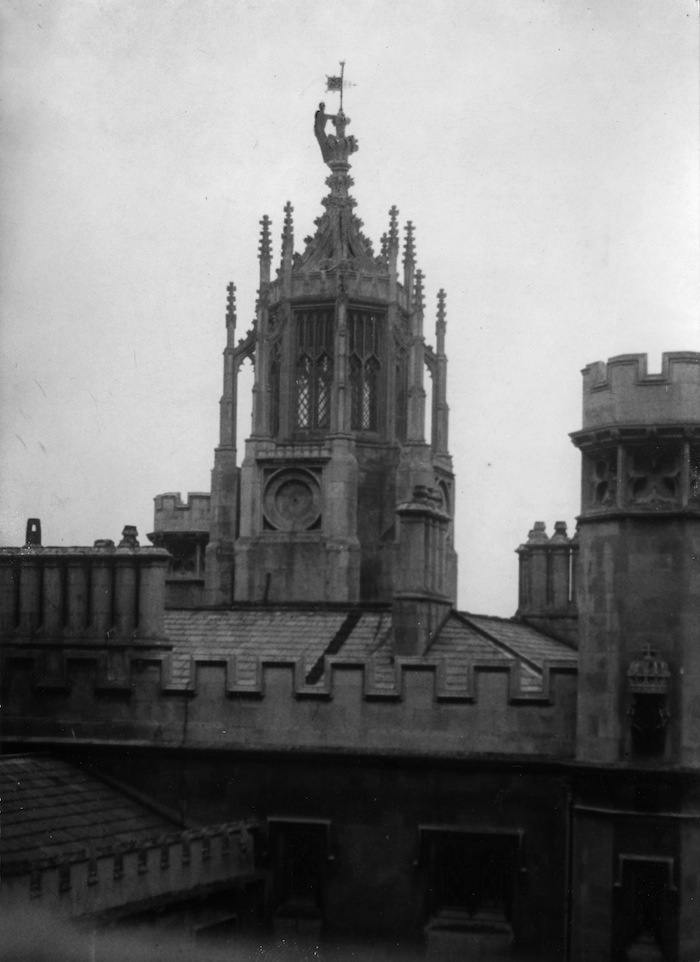
Advertisement
Thomas Mailaender: I bought the material from the son of Noël Howard Symington, author of the book The Night Climbers of Cambridge. He was at Cambridge University and was very bored, so he and his friends would climb the buildings of the university and the city at night. It was like the parkour of its day—if parkour wasn’t lousy. In the 1930s, climbing these buildings was a real act of disobedience. If they had been caught doing it, they would have been rusticated. Yeah, and I know it still goes on at Cambridge. Did these guys invent it?
Yeah, those guys kind of invented it, and it only became a classic thing to do afterward, because of the book. Photographing it turned it into a political act. They wanted to advertise their act by making the book. They were sending a message to the authorities: “We are doing this at night. Please come and catch us.”
Advertisement

No. I mean, maybe it wasn’t political. They were kids who were bored and stuck in their university and in their role. Maybe they’d work hard during the day, but at night they’d become creatures climbing around on roofs. I like that they were making these acts of disobedience at night and, of course, this idea of climbing higher and higher and taking risks is great. Why did you decide to use these photos in your own work?
As an artist, I use a lot of pictures from different sources that aren’t mine. Of course, I also take pictures myself, but a lot of what I do uses other people’s images. Sometimes that’s just stupid pictures from the internet, and sometimes—like in this case—it’s something more historical. Even though these photos are from the 30s and they’re very Cambridge, they still have this power of stupidity. This seems to be the connection with Extreme Tourism and Gone Fishing. Those books were very obviously funny.
What I like in those pictures is the prank style. Pranks are the best things ever, because you’re making something funny and this funny act can at the same time be political, in a way. There’s an element of danger in these photos, too. I think of life as a kind of playground and these photos really show that. They might be from the 1930s, but they feel linked with my work.

Ian Jeffrey writes about this in the text that goes with these photos. He talks about the depression in the 1930s and makes a link to the night climbers, that maybe they felt like they had no future. It’s a bit punk, right? "Let’s put our life in danger at night, because—why not?" Do you think about what kind of sense of humor you have and whether it’s a French kind of humor?
The prank is really important to me, which I don't think is French at all. My work is mostly shown outside of France. There are galleries in France that show my work, but sometimes people wonder what I’m doing. I feel like a tourist in Paris, but I like that. What do you think the French want from you? What would constitute a more French style?
French art right now is very, very serious, and much more conceptual. It’s ironic and sculptural. A lot of people in France think my work is about irony, but it’s not at all really. When I do a prank, I do it and I laugh and then I shift it to another context.
Advertisement

For me, this work is more of a curatorial project. I’ve made a huge climbing wall in the gallery, though, so that makes it a bit different. We’re going to show a picture six meters above the ground, which you can’t see if you don’t climb. Next year, we’re going to do it in Switzerland with a climbing instructor and climbing ropes so it will be secure. It’s a way of re-appropriating the images. It also gives people an idea of some of the danger that was involved in taking these photos. I mean, how were they taken?
You can see that, for most of the climbing, they have no climbing ropes and it’s really dangerous. The first photo in the exhibition is of one guy on the top of Trinity College—on the cross—which is maybe 50 or 60 meters high, and the guy is making a sign next to the cross. There’s something interesting about danger in a place that’s meant to be safe
It’s what I liked about these pictures, that these people were so bored and so safe that they needed this release. Some friends and I often say that we are too safe in our small life in Europe, and that sometimes it might be nice if a war happened. Not nice, maybe, but interesting for our life. In some of my work, I like to put myself in danger, in my very small way, and it’s a way to make my life just a little bit more interesting through art. The Night Climbers of Cambridge is at the Roman Road Project Space, 69 Roman Road, London E2 0QN, until Sunday the 20th October. For more about Thomas, visit his website.
Advertisement